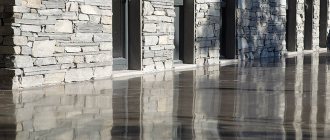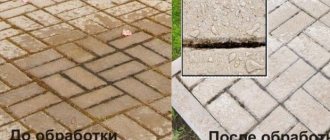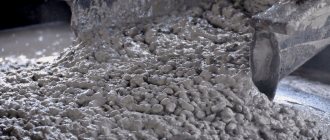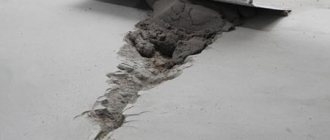No matter how high the strength of concrete is made, water will gradually destroy it. To reliably protect the surface, minimize its contact with moisture. And for this, a water repellent for concrete is successfully used. Let's consider the advantages of such processing, and analyze in detail the most popular compositions.
Hydrophobic coating for concrete Source multydecor.com.ua
Hydrophobic concrete
Ordinary cement mortar, even made from the highest grade, still has small pores and microcracks. And this negatively affects its strength over time. Because they are filled with water and begin to undermine the material from the inside.
There is a special standard for the moisture resistance of concrete. It is designated by the Latin letter W. After it there are numbers that indicate the degree of resistance. That is, what pressure of the water column can the solution withstand.
Water resistance characteristics of concrete:
- W2 is practically no different from a regular solution;
- W4-6 is used in private construction for the construction of houses, baths and even swimming pools;
- W8 is suitable for concreting the base;
- W10-12 is used to protect the foundation from nearby groundwater, as well as facades from precipitation;
- W14-20 is used for the construction of hydraulic structures.
All of the above solutions are hydrophobic concrete. It can be ordered from construction organizations in ready-made form. But, since the cost of such a service is very high, most developers prefer to make moisture-resistant concrete themselves.
Stone treated with water repellent Source garant-beton-gbi.ru
To do this, you can add special modifiers at the stage of preparing the solution. Or impregnate the outer layer of concrete with a moisture-repellent composition. In both cases, the surface will acquire the required level of moisture resistance, according to the additives introduced.
Rules of application
You can often come across negative reviews from motorists who bought a hydrophobic product, applied it to the glass, but were completely disappointed with the result. After this, there were angry comments addressed to the manufacturer and statements that it was pointless to buy anti-rain.
There are 3 main reasons why this happened:
- The car owner decided to save money by purchasing the cheapest product of dubious production. Such hydrophobes can indeed be completely disappointing. It is worth buying only proven liquids from leading manufacturers.
- A well-made product was purchased, but it turned out to be a fake. Alas, the growing popularity of hydrophobes has led to the appearance of a large number of counterfeit products on the Russian market.
- The product is good, not a fake, but the motorist simply did not follow the application rules.
It is the last problem that is talked about most often. Before complaining about the lack of anti-rain effect, carefully read the instructions and apply the product correctly.
Advantages of impregnation
Hydrophobization is a very useful process that increases the positive properties of concrete. Therefore, they try to use it everywhere. Moreover, when used independently, its cost is significantly lower than in industrial production.
The main advantages of hydrophobization:
- The surface acquires water-repellent properties.
- Corrosion of reinforcement is prevented.
- Replaces priming.
- Does not allow salt stains to form.
- Increases frost resistance.
- Protects the surface from vandalism (unwanted graffiti).
- Increases thermal insulation.
- Adds strength to the outer layer.
- Promotes resistance to destruction from sudden temperature changes.
- Does not allow fungus and mold to develop.
- Protects the surface from ultraviolet radiation.
- Increases the durability of the entire structure.
- Maintains air and vapor permeability.
Hydrophobization of facades Source hozsektor.ru
The above significantly increases all the performance characteristics of concrete. Therefore, this operation is equally popular among both novice builders and professionals. And everything that has been said clearly explains what hydrophobization is.
See also: Catalog of companies that specialize in finishing materials and related work
When to use
Protective equipment can be useful in several cases.
- Stone is used both inside and outside the building. In both cases, it may be exposed to harmful substances. These can be various solutions with a caustic composition, household chemicals, and even water. They can cause hard-to-remove stains on the surface of, for example, marble.
- Stone used for exterior decoration needs protection more than others. It can be affected, for example, by direct sunlight. Because of this, the same marble can become discolored and faded.
- Mold, moss, and fungi form on the stone. As these organisms grow, they can destroy the structure of the material and even the entire stone structure.
- The salt inside the stone, under certain conditions, can come out, crystallize and destroy the material.
Efflorescence on granite
Popular formulations
All water-repellent additives can be divided into two groups. The first includes water-based mixtures. And, paradoxical as it may sound, one moisture begins to protect the surface from another. Such compositions are capable of allowing steam to pass inside, but block ultraviolet rays.
The second group contains silicone. The component reliably blocks the passage of moisture and strengthens the surface. Both mixtures are absorbed by the surface of the finished concrete structure through capillary channels. Then, at the molecular level, a crystal lattice is formed that is capable of passing air currents.
Aquasil
A water repellent is not only reliable protection against water. The brand can significantly increase the moisture resistance of most types of concrete. At the same time, the strength characteristics of the latter increase by 1.3 times. And this allows you to increase the service life of the structure being processed.
Popular water repellent Source ru.all.biz
The drug goes on sale in concentrated form. Dilute it with water in a ratio of 1:10. It is characterized by a low alkali content and resistance to high temperatures. The composition is explosion-proof, and waterproofing of facades is carried out no more than once every 10 years.
What is hydrophobe used for?
Really high-quality hydrophobic protection designed for car windows is capable of much. To be more precise, it performs well the tasks assigned to it in the form of improving the visibility of what is happening on the road.
There are several main functions that a hydrophobe or simply anti-rain copes with.
- The visibility from the vehicle's cabin is noticeably improved during heavy rains. Drops, once on the windshield, quickly drain under the influence of gravity and are swept away by oncoming air currents. Depending on the intensity of precipitation and the speed of movement, sometimes it is not even necessary to turn on the wipers to keep the glass clean and clearly visible.
- Provides additional protection for the glass itself from mechanical stress and damage. Yes, such a thin film will not save you from a stone flying out from under a car wheel. But anti-rain can protect against the formation of scratches from the work of wipers, small grains of sand and abrasive dust.
- The service life of wipers is increased. There are 2 main reasons why this happens. The first is less active use of the windshield wipers themselves. The logic is simple: the less often the brushes are turned on, the less they wear out. The film also creates a smooth and slippery surface on the glass, which makes it easier for wipers to walk on. This reduces the load on the electric motor responsible for moving the brushes, and with it on all other components.
- Cleanliness is maintained. The windshield is more susceptible to contamination than others due to puddles and cars ahead. Hydrophobe does not allow dirt to linger on the glass, and therefore it remains clean and requires less attention and maintenance.
- Reduces windshield washer fluid consumption. The glass does not get dirty as intensively, the wipers are used less frequently, and therefore consumables in the form of windshield washer fluid are consumed in smaller quantities.
Criterias of choice
When selecting the composition, the following points are taken into account:
- Technical characteristics of water repellent.
- Features of the treated surface.
- Brand image.
- Manufacturer's recommendations.
- Cost of the drug.
Experts advise using silicone-based impregnation. When used, a durable film will be created that will not allow water to penetrate inside, but will allow air to pass through. It should be remembered that in this case it will no longer be possible to paint the surface. But this could be an additional advantage, since vandals will not be able to leave their autographs in the form of graffiti on the walls.
Why is water dangerous?
Many people are familiar with the effects of moisture. As a result of a violation of the steam exchange regime, the following may occur:
- mold and fungal formations both inside the building and on the outer surface of the walls;
- wet areas, for example, at the joints of vertical walls and canopies over balconies or loggias.
The most unpleasant thing is freezing, which becomes more intense the more moisture the building or finishing material absorbs. Also a familiar manifestation of an excessive level of water saturation is the so-called salting, whitish spots on the surface of the facade.
In cold climates, excess moisture levels in the wall material (masonry, cast, composite) lead to rapid destruction of the plaster, peeling and even destruction, which lead to loss of structural strength.
At low temperatures the following occurs:
- water that gets into the pores of the material or cracks freezes;
- the resulting ice has a larger volume than freezing water;
- The cracks in the material expand, the partitions between the pores are destroyed, this leads to a loss of strength of the material.
Briefly about the main thing
If you need to increase the moisture resistance of concrete, you can go in two ways. Even at the stage of creating a cement mortar, components are added to it that increase its water-repellent properties. Most often, this method is used when it is necessary to build hydraulic structures.
In the second case, the finished concrete structure is impregnated with a water repellent. Most compounds work at the molecular level. Penetrating deep under the surface, a chemical reaction creates a crystal lattice that does not allow moisture to pass through, but allows air to pass through.
Other impregnations simply form a durable, colorless film with the same properties on the concrete surface.
Removing a tool
If the hydrophobic agent is applied correctly according to the instructions, there is no need to remove it: after its service life, the coating itself will wear off evenly. However, such a need may arise if the first time the treatment was of poor quality or the water repellent needs to be changed. In this case, remove the protective film from the car using regular ethyl alcohol or a special means for removing water-repellent compounds (they are usually sold in stores offering coatings) using circular movements. After removal, wipe the machine with a soft cloth.
Peculiarities
During the distribution of the composition, the ambient temperature is of great importance
It is important to follow the manufacturer’s recommendations, since violation of the established rules can lead to a decrease in efficiency
Applying water repellents is similar to painting walls. Special sprayers provide high speed work, but you can get by with the usual roller and brush. It is easier to prevent any problems than to deal with their consequences. Therefore, if cleaning of facades from efflorescence and hydrophobization is compared, the latter option becomes more preferable and long-lasting.
Stages of hydrophobization
All hydrophobic solutions have a high degree of adhesion, so they easily adhere to any building materials, even metals.
Preparation
The preparatory process includes:
- Repairing façade defects.
- Its alignment.
- Primer.
Carrying out work
Protective compounds are applied to building facades in different ways:
- If these are multi-story buildings, then the ideal option is by spraying.
- If these are private one-story houses, then you can do everything yourself, using ordinary paint brushes and a roller.
Please note that uniform application of the hydrophobic solution on the facade is the key to the quality of the final result. If it was not possible to apply the protective material evenly, then do not be upset.
You can apply a second layer again. But at the same time, keep in mind that re-application of the solution should be carried out over the still wet first layer.
«>
How hydrophobization works
Hydrophobization of a facade or wall allows you to neutralize the harmful effects of water. Moisture simply does not penetrate the pores of the material.
Advice from the “façade designer”
Unlike waterproofing, hydrophobization is the filling of the pores of the material, and not the formation of a durable waterproof film on the surface of the processed materials.
As a result, walls that have undergone hydrophobization maintain vapor exchange rates and “breathe,” which ensures an excellent indoor microclimate and the lifespan of façade coverings planned during design.
Positive aspects of the hydrophobization process
- lack of moisture absorption even with direct exposure to water, for example, during rainstorms or facade washing procedures;
- indicators of air and vapor exchange of materials, brick, concrete walls, plaster finishing are maintained;
- dryness is maintained throughout the entire layer of masonry or volume of the concrete wall, which guarantees long service life of the structure;
- frost resistance increases, this leads to both an increase in the strength and operating time of buildings with planned indicators, for example, the load on interfloor floors;
- hydrophobization of a facade or wall can be used both to protect industrial buildings and residential buildings or private houses;
- the compositions used to protect the wall material do not allow the formation of mold or fungal colonies;
- solutions for hydrophobization are colorless and do not affect the appearance of the material from which the wall is made, which is especially valuable when it comes to processing finishing made of decorative brick or natural stone.
The surface treatment process is carried out quickly, using a minimal set of tools; the use of sprayers dramatically speeds up the work. As a result, it is simply impossible for salt stains to form on the wall; the facade acquires new properties: dirt and dust can be easily washed off from the finishing surface or wall without the danger of moisture penetration.
Hydrophobization: definition of the concept
Before carrying out work to protect a building from destruction, you should decide: façade hydrophobization, what is it? The general concept includes a set of measures to effectively protect building facades from destructive processes associated with the ingress of moisture, water under the influence of temperatures and other external factors. This is the most effective and most economical way to protect the surface of ceramic and silicate brick and cellular concrete walls from the destructive effects of moist air penetrating the porous structure and filling the voids with moisture.
When the temperature drops, water freezes in the pores and presses on their walls. Then the defrosting process occurs. Salts in the wall material absorb liquid, destroying the masonry. Under the influence of sunlight, the water-salt solution evaporates, the salts crystallize, forming hydrophilic formations of significant volume. All these processes negatively affect the masonry: the appearance deteriorates, its peeling appears, deep cracks and smudges form, both on the building material and on the plaster layer. Rust gradually “eats” the metal structures inside the cladding.
Another sign of insufficient protection of facades is the formation of numerous shapeless white spots (efflorescence). As a rule, these are water-soluble sulfates, which appear with constant persistence in the most unexpected places. Simple mechanical treatment of spotty areas with a jet of water is not only ineffective, but also leads to excessive wetting of the facade. It should be borne in mind that an increase in the humidity of walls by only 10% provokes the loss of half of their heat-shielding properties and significantly cools the house. In such cases, hydrophobization of the facade does not destroy the wall material, but creates water-repellent, completely invisible visual protection. The surface is coated with a deeply penetrating substance that prevents moisture from penetrating into the structure of the material.











